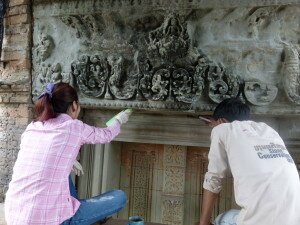
Consolidation of decayed stone surface areas at linel – Prasat Pre Rup
10 April 2018
In March 2007, three local stone conservation experts, with the support of one German Development Worker, started their assignment to establish a competent and fully qualified unit of local stone conservators within the APSARA Authority, the local governmental body tasked with the management and protection of the Angkor World Heritage Site in Siem Reap. And now, ten complete years thereafter the results are compelling.
The temples of Angkor are in constant need of maintenance and care. Having been exposed over a period of hundreds of years to … More >>>
